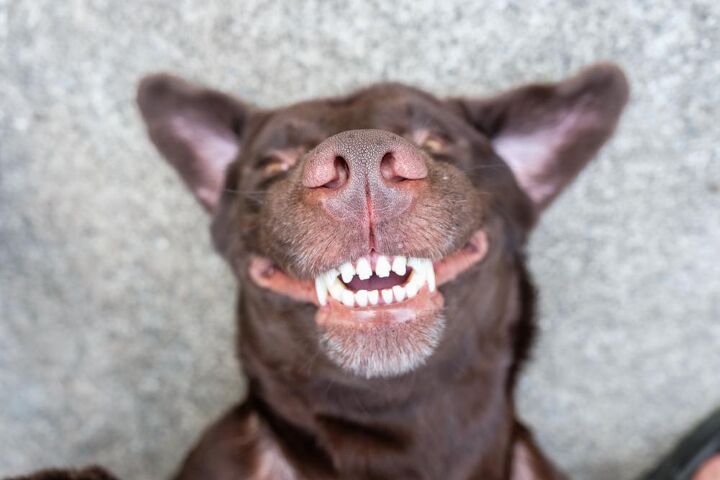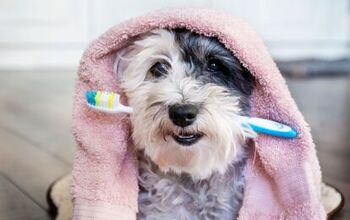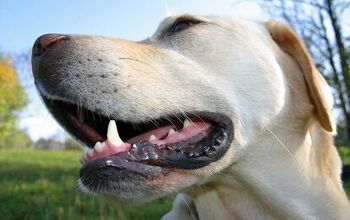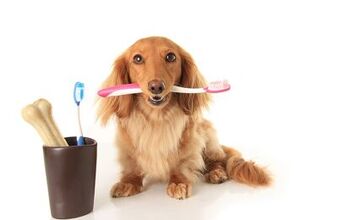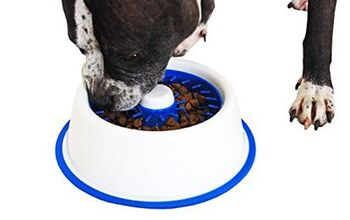How to Clean Dog Teeth Without Brushing

If your teeth start to feel a little fuzzy after a long day, you probably give them a good brushing or at least a quick rinse with mouthwash. The chances are that your dog doesn’t care too much how his teeth feel, but oral hygiene is still important. By the time they are three years old, most dogs and cats show some degree of periodontal disease.
Brushing your dog’s teeth is the most thorough way to clean them, but it isn’t the only option. This is good news if your dog has trouble sitting still! Read on to learn some alternative ways to clean your dog’s teeth without brushing.
Related: Top 15 Toys for Clean Dog Teeth
Tips for Cleaning Dog Teeth without Brushing
If you want to brush your dog’s teeth, it’s not something you can just start doing. It often takes days or weeks of getting your dog used to the brush and brushing a few teeth at a time until your dog is able to sit still for the whole endeavor. So, what do you do in the meantime? Or if your dog never gets used to having his teeth brushed?
Here are some simple tips for cleaning your dog’s teeth without brushing:
- Consider human foods.
Believe it or not many dogs LOVE fruits and vegetables. Some even prefer them over meats. No, it’s true–I have a Lab mix and she’ll pick cucumber quarters over a piece of raw meat any day. That may be because she prefers her meat cooked, but still…the point is that dogs do like human vegetables and fruits. They’re low in calories and fat and if you give them stuff like carrot sticks, sweet potato, uncooked pumpkin (they can’t get enough!) or apple sticks, you’ll be helping them to scrape plaque and tartar build-up off their teeth and they’ll think you’re just giving them treats. Win-win! - Dog tooth wipes. If your dog won’t let you brush his teeth, he might sit still long enough for a quick swipe of a dog tooth wipe. These wipes are designed to be rubbed against a dog’s teeth to remove plaque and work in a similar way to brushing, though they can’t get into the nooks and crannies as well as a brush an.
- Dog dental treats. Your dog will always accept a treat, even if it’s good for him! Dog dental treats are usually made with ingredients designed to freshen breath and are usually crunchy to help scrape plaque and tartar off the dog’s teeth as he chews. They come in all sorts of sizes, shapes, and flavors to appeal to your dog’s preferences.
- Dog chews. Many dog chews offer some degree of dental benefit because, simply by using his teeth, your dog can protect them. Gnawing on certain materials scrapes plaque and tartar off the teeth and many chews contain natural enzymes that help promote your dog’s dental health. Try things like cow ears, chicken stripes, and bully sticks or hard rubber toys like Kongs.
- Food and Water Additives. There are lots of options when it comes to water additives to help keep your dog’s teeth clean. They work to treat plaque, bacteria and tartar in your dog’s mouth by working with your dog’s saliva and breaking down biofilm on their teeth and gums. Some food additives, like Bernie’s Perfect Poop, work by helping keep your dog’s gut healthy and treating teeth from the inside out.Water additives are also another option that pet parents like. They work to change the pH of your dog’s alive and that helps control their tartar production in general.
- Professional cleanings. If you really want to keep your dog’s teeth clean, you should have them professionally cleaned about once a year. Your veterinarian knows your dog well and is familiar with his issues, including dental problems, so he is the perfect person to help you maintain your dog’s dental hygiene. A professional cleaning might be pricy but it is well worth it.
Though it may sound silly to brush an animal’s teeth, oral hygiene is just as important for your dog as it is for you. Neglecting your dog’s dental health can lead to serious problems like gum disease and tooth loss.
But we get that brushing your dog’s teeth may be tougher, so taking some gentle steps toward getting there with some of these tips can definitely make a difference. It is never too early to start taking care of your dog’s teeth, so be encouraged.

Kate Barrington is the loving owner of two cats (Bagel and Munchkin) and a noisy herd of guinea pigs. Having grown up with golden retrievers, Kate has a great deal of experience with dogs but labels herself a lover of all pets. Having received a Bachelor's degree in English, Kate has combined her love for pets and her passion for writing to create her own freelance writing business, specializing in the pet niche.
More by Kate Barrington



